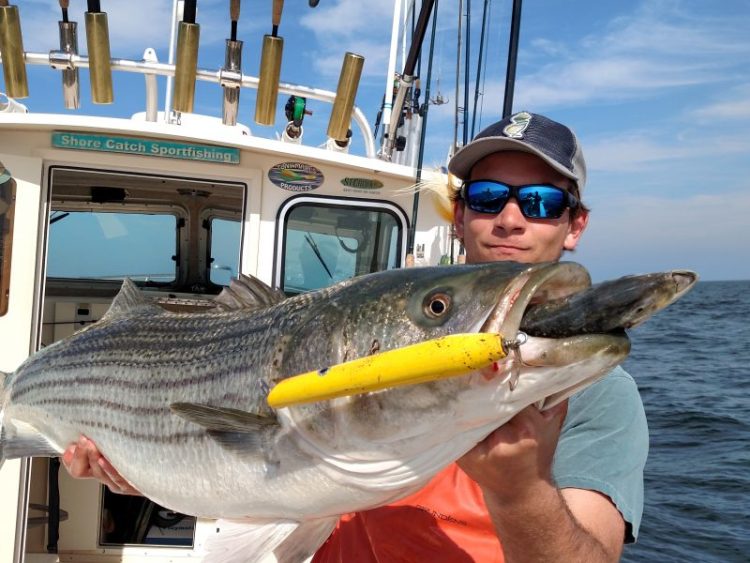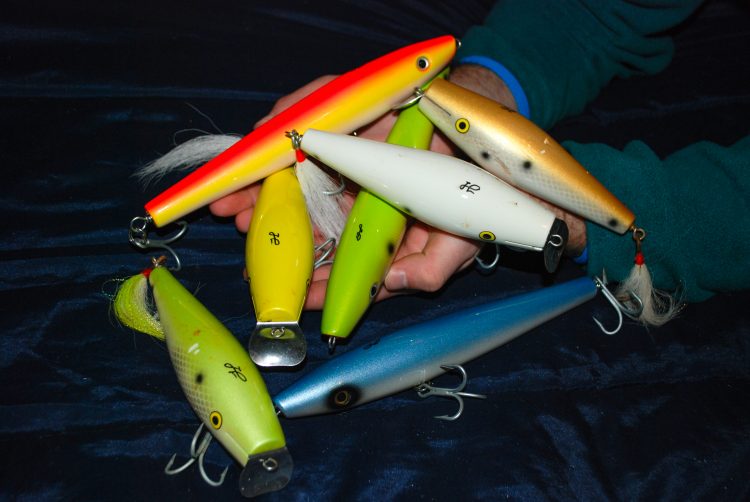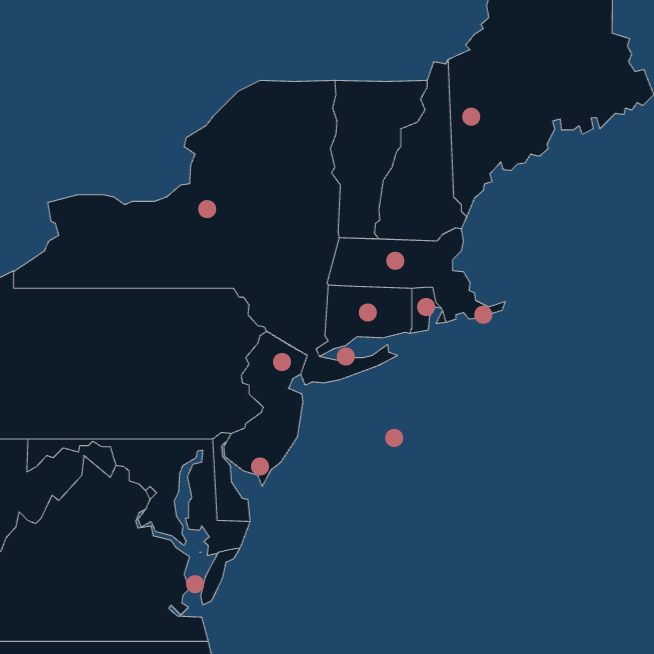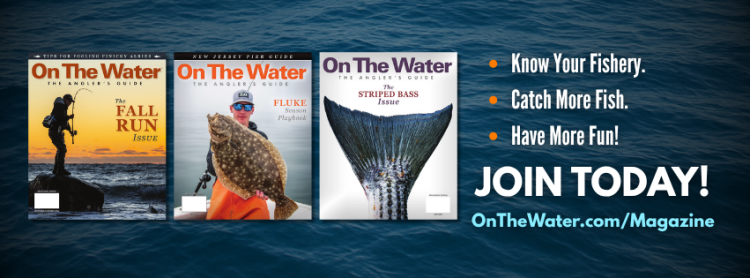
There are a wide variety of ways to catch large striped bass. Trolling bunker spoons, mojo rigs, or tube-and-worm rigs always accounts for a good number of striped bass over 40 pounds every year. Fishing live bunker, mackerel, or eels is probably the highest percentage way to catch a trophy bass, but in my opinion, the ultimate approach is to target big stripers on topwater plugs and lures.
Big stripers don’t always show themselves on the surface, but I am always rigged and ready with the right spinning rods and reels for when the opportunity to cast to big stripers presents itself. Rods are set in my rocket launchers with swimming plugs, pencils, and poppers ready to grab at a moment’s notice.
(Note: On The Water is reader-supported. When you buy through links on our site, we may earn an affiliate commission.)
Finding Big Striped Bass on Top

When looking for a topwater cow, I often cruise around looking for signs of stripers hunting near the surface. The most obvious sign is seeing stripers blowing up in the middle of a baitfish school; a more subtle sign is a school of baitfish tightly balled up and acting “nervous.” When bass are right underneath the bait but not showing on the surface, the school will ball up tightly, become darker in appearance, and almost look like it is shimmering. Wherever I see this action, I make a cast directly into the center of the bait and get ready for a violent strike.
New England waters are rich in rocky structure where stripers hunt without showing themselves on the surface. Casting topwaters into those shorelines and working them back toward the boat can generate some impressive topwater strikes, even when there are no visible signs that stripers are nearby. Focus on points, riplines, and coves when searching for likely places to fish a topwater.

Finding a Nervous School
When looking for a topwater cow, I “pod hop,” meaning I move between schools of bunker looking for signs that stripers are hunting the baitfish. The most obvious sign is seeing stripers blowing up in the middle of a school of bunker; a more subtle sign is a school of bunker tightly balled up or acting “nervous.” When bass are right underneath the bait but not showing on the surface, the school will ball up tightly, become darker in appearance, and almost look like it is shimmering. Wherever I see this action, I make a cast directly into the center of the pod and get ready for a violent strike.
Landing Big Stripers on Topwater
While there are many aspects of fighting a giant striped bass of a lifetime that are exhilarating, I think the landing is the most nerve-wracking. One of the biggest mistakes I see is when an angler attempts to land a big fish from a boat and fails to keep the bag of the net from tangling with the trebles of the plug. This happens when the bag hangs freely while the net man goes to scoop the fish. To prevent this, take an elastic band and slide it up the pole and over the bottom third of the bag, holding it against the pole. When the bass is close enough, scoop under the head and lift. The elastic holding the bag will now break and the bass will drop into the net.
Rigging for Topwater Striped Bass
I use an 8-foot medium or medium-heavy power rod to cast my topwater lures. The 8-foot St. Croix Mojo Salt medium power is the rod I like to use because an 8-foot rod gives me more casting distance than a 7-foot rod and is not too long to use on a boat. The extra length also allows me to maintain enough distance from the surface-feeding bass so I can reach them without putting them down.
My spinning reel is spooled with 40-pound-test braided line attached via an FG knot to a 40- to 50-pound-test fluorocarbon leader. My lure is connected to my leader with a 175-pound Tactical Anglers Power Clip.
Local Lumber: Guppy Lure Company Pencil Poppers
There are many different topwater lures that can be cast around the bunker schools and they will all catch. A favorite among New England fishermen are the Guppy Lures pencil poppers for their long-casting and easy-walking design. Yellow over white and blue over white are my preferred colors. These pencils have narrow heads and flared, weighted tails allowing them to cast long without tumbling or helicoptering through the air, which makes it very easy for my clients to cast. Many of the Guppy pencils feature a flat bottom design, making them easy to work across the top of the water.
This flat-bottom pencil style was first designed by the late Stan Gibbs, who took the common rounded pencil and sanded a flat spot on the bottom. It became known as the “Cape Cod Canal Special.” The design helps a fisherman easily work the pencil back and forth along the current of the Cape Cod Canal. The flattened bottom gives the lure the ability to get on top of the current with ease in order to maintain its side-to-side motion.
Swimming Plug Legacy
Plug builder Tom Brown came on the scene several years back and quickly broke into the elite group of plug builders with his swimmers and spooks. “It all started in 1980 when my grandfather Joseph Pfister, an avid carpenter and fisherman, started making fishing lures,” said Brown. “He taught people, like renowned plug builder Billy McFadden, many key components about building fishing lures such as how to through-wire. Fast-forward almost 40 years, during which I spent countless hours watching my grandfather work in his shop, and I now carry on the JP legacy.

“What makes our Surfster work so well,” Brown continued, “is that it has a wide-bodied profile but a more compact design that will produce bites from fish of any size. That V-waking wiggle really seems to draw them in”.
I can attest to the striped bass catching success of JP plugs because the largest plug-caught striped bass ever caught on my boat, a 49.5-pounder caught by Max Kristiansen of the Manasquan High School Fishing Club, came on a bunker-colored JP Surfster.

On that day, I had to cancel my charter due to 20 mile-per-hour winds out of the north; instead, I decided to go for a fun trip, despite the challenging conditions, and brought along Max and my son, Tommy. We headed north, into the teeth of the swell, with waves crashing over the bow, and saw a pack of birds in the distance. Upon pulling up to them, we saw big bass blowing bunker clear out of the water. Max grabbed the rod rigged with the Surfster, and on his first cast into the melee, he hooked the fish of a lifetime.
Related Content
Topwater Walkers for Striped Bass


Great article
Focus on points, riplines, and coves …great article but remember we all dont know exactly what the above means..newbies need help too